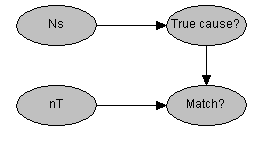Bayesian matches
The probabilistic argument used for simple matches, for belief concerning the true cause of a typed report, can be developed in a fully Bayesian framework.
In a Bayesian belief representation an observed match, “Match?” = 1, at a randomly chosen source depends on whether that source is the “True cause?” of the report. The conditional probability table for the observed match is conveniently written as
p(“Match?” | “True cause?”, nT) = Binomial(1, 1) if “True cause?” = 1 else Binomial(1, nT-1)
where the number of types, nT , determines the random matching probability. In the Bayesian representation the observed match, an observable, is explicit and the number of unobserved matches, i.e. m – 1, is implicit. Prior beliefs about the true cause depend only on the number of (equivalent) sources, NS, and a network representation again has four nodes. A domain model is shown below.

In this network it is plain that observing a match at a random source, out of 101 sources, changes belief about causality to above 71% when there are 250 distinct types. In some respects the explicit appearance of the observed match ensures that the fully Bayesian representation of events is more useful for biotracing applications.
Ns
nT
Match?
True cause?